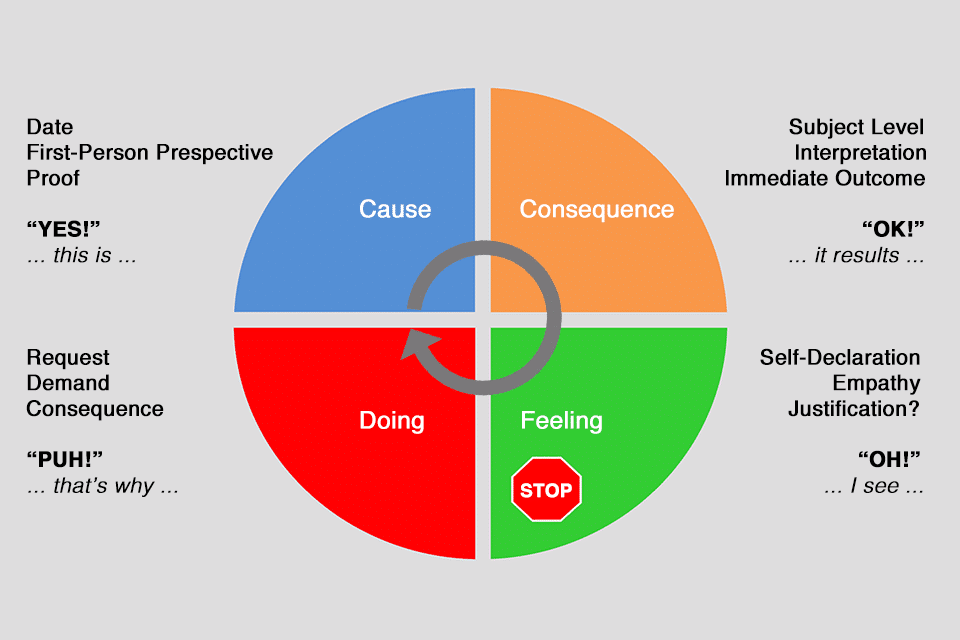Corporate communication with methods
Communication culture in challenging times
“As much as necessary, that’s enough” is an admittedly rather flat slogan for the prevailing communication culture in companies. Emails and circulars are written for holidays or seasonal highlights, which are purely informative or self-portrayal in character. Special attention is then paid to an anniversary publication on the occasion of the 150th anniversary of the company, which is a glossy brochure showing the development of the company in colourful pictures and historical photo collages distributed by all employees to them and all business partners. This is sometimes reminiscent of high school newspapers or club magazines.
This may sound malicious and irritate some people. Communication culture becomes particularly explosive when difficult situations arise, and not only since the Corona pandemic. We are also familiar with this phenomenon in the private sphere, where family celebrations on pleasant occasions show a certain lightness, but in the case of family conflicts, the way we deal with each other sometimes becomes very unpleasant for all concerned. What is the reason for this?
Emotions as an expression of needs
In conflicts the famous gold balance comes into play. We place words and patterns of behaviour on them when they come too close to our own needs and values, when they touch us emotionally. Emotions are the messengers of needs.
Very strikingly, people have represented 3 basic needs:
- security,
- affiliation and
- growth.
Emotionality is always present when the filling level of one or more needs does not correspond to the minimum reserve.
The current example of the corona crisis is unfortunately a prime example of this view. There is a great deal of uncertainty as to what will happen in the economy and in social life, and this creates a certain thin-skinnedness. Due to contact restrictions, the need for belonging is severely restricted and demands a high degree of “endurance” from all people. The need for growth recedes, but then becomes apparent in those places where people ask how things will continue after the crisis and what opportunities it could offer.
Derived from this, an essential task for corporate communication arises: All publications and at all points of contact it is necessary to fill the “need deficits” of employees, but also of partners and customers.
A fictitious example
The following hopefully fictitious situation illustrates this from the personal sector: One of your relatives is in a hospital or nursing home and you call to inquire about their well-being. As an answer they receive: “The blood pressure is 140 to 85, the sugar is well adjusted and the food intake is sufficient!”
This purely factual information will probably not reassure you much, although all the relevant facts have been precisely stated. Your need for security was only insufficiently satisfied because the remaining components of the transmitter-receiver model (self-knowledge, relationship and appeal) were swallowed.
“Mr. Michalski, the medical values are ok and your uncle is on the road to recovery. He will be pleased that you have asked about him. so don’t worry about him.”
Linguistically still to be smoothed out or varied, twice the word count and yet more reassuring than the initial medical bulletin.
My 5 points of corporate communications
In connection with successful corporate communication, there are numerous orientation aids. In my opinion, the following 5 points are a guideline to optimise the impact and at the same time promote employee loyalty and cohesion:
- personal
- permanent
- suitable
- public
- professional
To 1. personal:
With personal I like to address the owner, the managing director or executives as a directly experiencable person. As an employee I want to have the feeling of personal contact with my direct superiors or my employer – no press releases with “one should” phrases or empty slogans. Particularly in times of asynchronous communication via technical aids, people need an individual, personal approach.
To 2. permanent:
How many times a day do you look at news tickers, social media accounts or press releases in order to have the good feeling of being up-to-date? This is exactly how employees feel in tense times, as they need a permanent, accessable flow of information to calm them down.
To 3. suitable:
General wording and static terms tend to convey a sense of distance. The target group orientation known from marketing is the measure of all things here. An administrative employee has different information needs than the sales force. The same differentiation applies to customers, cooperation partners and suppliers.
To 4. public:
The choice of the appropriate communication channel depends on both the technical accessibility and the consumption habits of the target audience. The range here extends from the classic posting on the employee information board to newsletters, infoboards at the workplace or on the Internet to audio or video messages.
To 5. professional:
The professionalism of the publications mentioned is less dependent on rhetorical or technical quality. This is more about a goal-oriented structure and a certain basic level of preparation, presentation and implementation. You are not pitching for an order in front of customers but in front of your employees!
Ultimately, the all-decisive question that every consumer asks himself is your message: What use is it to me? What do I get out of it? And how does it secure me?
The 4/4 = 1 method
I would like to present a concrete model of corporate communications to you. Imagine you want to send a video message. How do you proceed in terms of content or methodology?
- First, describe the facts or the real situation with factual substantiation.
- Explain the resulting consequences and implications.
- Express your own emotional part and the reference of the target group.
- Formulate a request, a wish or a demand.
So it is about the cause, the consequence, the feeling and the doing. Overall, you should formulate each point concisely, clearly and precisely. And then remain silent.
Graphically this procedure – I call it the 4/4 = 1 method – can be represented as follows:
Which segment is used to start with must be determined according to the respective situation. Sometimes it is appropriate to start with the feeling, in the case of vitalisation speeches the invitation as an appeal at the beginning is the goal-oriented variant. The title of the model “4/4=1” points out: only if all 4 parts come together, it will become a round speech.
And: Action
All these thoughts result in one extract: Action!
Whether they like it or not, in crisis situations those responsible are in demand as lighthouses and sovereign leaders who provide orientation and trust.
That’s why this article ends with the wish that crisis or corporate communication is planned in advance like a marketing campaign with a detailed list of frequency, topics, channels, and target. I wish you personally and your company good health and economic success.
Note:
Christoph Michalski has written a helpful book (in German): Die Konflikt-Bibel.
„Höchst unterhaltsam, mit ausgeprägtem Selbstbewusstsein verfasst und voll von persönlichen Erfahrungen, historischen Querbezügen und prägnanten Beispielen.“ – Mark Hübner-Weinhold, Hamburger Abendblatt

Christoph Maria Michalski
Christoph Maria Michalski has been self-employed as “Der Konfliktnavigator” (The Conflict Navigator) since 2010. The former managing director of an educational institution with over 700 employees has been through (almost) everything from expansion to the deletion of a GmbH – every grey hair an experience!
The seniorable lateral thinker deals primarily with questions about the emergence and correct handling of conflicts of all kinds: conflicts in teams, conflict resolution, role conflicts, conflicts with customers and suppliers, conflicts at the workplace. In his proposals for solutions, he combines creative approaches with methodological diversity and technical precision. The basis for this is not only his irrepressible curiosity, but also his three university degrees as Rhythmics Teacher, Adult Education Teacher and MSc in IT Management.
On a voluntary basis, he is the Lower Saxony representative of the Mediation e.V. Foundation. He is also a lecturer at the HAUFE Academy and the Leaders Academy, and an expert on SAT1 breakfast television.
His passion for motorcycling and magic continues to influence his work and way of thinking, as he is a member of the Magic Circle of Germany.
